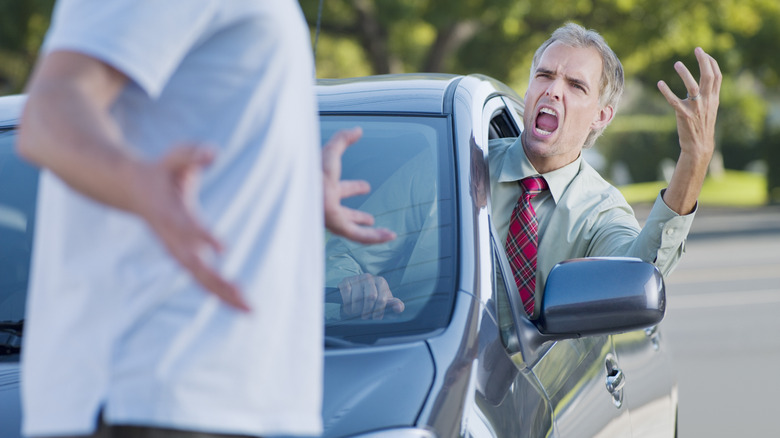The Frustrating Reasons Why Cities In America Are Not Walkable
"HEY, I'M WALKIN' HERE!" One of the most famous scenes in movie history is when Ratso (Dustin Hoffman) nearly gets run down by a taxi on a New York City side street. His cigarette drops out of his mouth, he bangs the car's hood, and he hollers at the driver. Cars honk and cussing ensues. This vignette, from the 1969 drama "Midnight Cowboy," is tense and angry. It's even worse to watch today, because walking in a U.S. city can be just as unpleasant as it was half a century ago. The only real improvement? It's slightly less likely that anybody would be smoking (although still very possible).
Visitors to the United States are often flummoxed by the simple act of getting around. Ground transportation from the airport can be confusing and expensive. Many Greyhound terminals are in a state of disrepair, and bus trips could take all day to go a not-very-long distance. Amtrak trains are so consistently delayed that passengers should just assume they won't arrive on time. Meanwhile, affordable hotels are often located in remote suburbs, far from the city's culture and action.
Once you get downtown, many U.S. cities are awful for pedestrians, with uneven pavement, faded zebra stripes, and sidewalks that simply end. Statistically, putting one foot in front of the other in a public space is actually dangerous: Cars killed about 20 pedestrians every day in 2022, marking a 40-year high, according to NPR. The fatality rates in some cities are particularly horrifying, but suffice it to say, wherever you walk in the U.S., you're taking your life into your own hands.
How cars took over the United States
There are many reasons the U.S. became so hostile to walkers, but the clearest cause was the personal automobile. American industrialist Henry Ford was the first to manufacture cars en masse with the famous Model T in 1908, and car ownership has ballooned ever since. The 1950s saw massive changes in the American landscape: The G.I. Bill helped millions of veterans buy houses in the suburbs, which were only accessible by car. Drive-in restaurants like Sonic (first called Top Hat) catered to diners seated in their cars, and thousands of copycat fast food joints popped up along major motorways, adding to rampant sprawl.
Then came the highways: Under the Eisenhower Administration, the Federal-Aid Highway Act of 1956 initiated a $25 billion road-building boom. The original plan was 41,000 miles of interstate highway across the U.S. by 1969; the system now runs a total of 46,876 miles. The novelty has worn off a bit, now that Americans spend an average of 25.6 minutes driving to work each morning; but an entire generation remembers these halcyon days, when camper-vans, epic road trips, casual hitchhiking, motorcycle rallies, and roadside motels were still new and exciting – and the road trip is still a mainstay of American culture.
Today, more than half of Americans live in suburbs, where long distances, patchy infrastructure, and car-dependency are the norm. All of this is bad for pedestrians, especially travelers who like to walk. Meanwhile, this mass migration leached energy and financial investment out of historic cities, and urban districts were left to fall into disarray.
The slow return of US cities built for people
Here's the good news: Many U.S. cities are starting to address this problem. A lot of folks prefer to walk, of course, especially visitors trying to connect with the local culture, and there are also the roughly 28 million American adults who don't have a driver's license at all. Fewer U.S. teens are rushing to pass their license exam, and many aging Boomers are no longer permitted to drive. Meanwhile, cities shouldn't just be "walkable," but "multi-modal," accommodating a wide range of physical disabilities as well.
Some cities are ahead of the curve. New York is famous for its subway system, level streets, and functional sidewalks. Not only is New York one of the "most walkable" cities in the U.S., but it's also a favorite among international travelers. Historic destinations like Boston and San Francisco have retained their old mass transit, and century-old neighborhoods are still designed more for people than cars.
Meanwhile, some U.S. cities are rezoning their downtowns for pedestrian malls. Famous examples include the mile-long 16th Street Mall in downtown Denver, the car-light Seaport Village in San Diego, and the Downtown Mall in Charlottesville, Virginia. Washington, D.C., is famous for its well-planned municipal spaces, and the grassy National Mall dates back to the 1930s. As bicycles, scooters, and ride-share services become ever more popular, lots of travelers are exploring U.S. cities in other ways, as well. Indeed, here are 14 places in the U.S. where cars aren't allowed at all. Because, hey, you're walkin' here.


